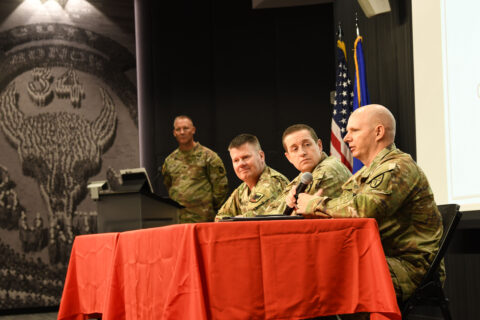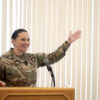U.S. Army artillery, intelligence communities meet to prepare for the ‘Army of 2030’ changes

From Sept. 7-8 2023, Army personnel from the artillery, known as ‘fires’, and intelligence communities, from across the active duty and National Guard components alike, descended upon the 34th Red Bull Infantry Division headquarters in Arden Hills for a second-annual symposium.
Unlike last year’s Fires Symposium, this event was redesignated as an Intel and Fires Symposium. In keeping with the U.S. Army’s strategic vision for the future, known as the ‘Army of 2030’ which is driving the implementation of significant force structure changes, the leadership of the 34th Red Bull Infantry Division and 34th Division Artillery constructed an itinerary which emphasized the importance of synchronizing the efforts of separate warfighting functions.
“We were very deliberate in saying that intel goes first, then fires, then targeting, because targeting is the integration of intel and fires,” said Army Col. Eric Wieland, commander of the 34th Division Artillery, known as DIVARTY.
Day one of the two-day event had briefs and panel discussions which brought together some of the best representation the National Guard Bureau and the Fires Center of Excellence could provide. One keynote speaker, Army Lt. Col. Christopher Isch, provided unique insights to the audience based on his role as the senior National Guard advisor at Army Futures Command’s Long-Range Precision Fires (LRPF) cross-functional team.
“One of the benefits that the LRPF has is that we are at Fort Sill,” said Isch. “We are with our center of excellence. We are quite literally across the street from the Fort Sill [commanding general] who is the [field artillery] modernization proponent for the Army.”
A consideration the Army must make, however, is that approximately 40% of the total Army force is in the National Guard. Further, 60% of Fires units in the Army are in the National Guard. There are problem sets that are unique to the National Guard when it comes to things like fielding equipment, resourcing the units, and conducting training at the individual, unit, and collective levels.
“As the National Guard stands up its [division artillery units] we’re kind of focusing on the division for a couple of reasons,” explained Weiland. “For one, the Army of 2030 has explicitly said that the division is the unit of action. It is the tactical echelon headquarters that has enough robust capabilities to do multi-domain operations. It’s probably the lowest echelon that is doing multi-domain operations in large scale ground combat operations, which is a pivot from what we did before where brigades had the capability to conduct large-scale ground combat operations.”
While divisions may take the helm as the unit of action, they are still powerless to engage in fight without the maneuver units under their purview. For this reason, the Red Bull Intel and Fires Symposium was a two-day event. Day two was centered around the challenges that National Guard field artillery are faced with, as well as ways forward to improve field artillery operations in the 34th Red Bull Infantry Division, alongside the units who are aligned-for-training.
Headquarters and Headquarters Battery, 34th DIVARTY First Sergeant Jonah Jenniges was a primary planner for the day two symposium events. “Battalion level staff officers and battalion master gunners were the main target audience. [That event] provided the 34th DIVARTY master gunners the opportunity to create a shared understanding of the DIVARTY commander’s vision for the 34th ID fires community for the Army of 2030.”
The event offered peers the opportunity to learn from one another, as well as share and discover best practices for targeting, training, and everything in between.
“It’s good to come back and engage with National Guard divisions, especially as they’re going through this transformation of standing up the DIVARTYs,” said Isch. “And really making a fundamental shift in the way that we fight fires across the National Guard component.”
By Lt. Linsey Williams
Minnesota National Guard Public Affairs



